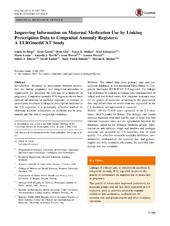| dc.contributor.author | de Jonge, Linda | en_US |
| dc.contributor.author | Garne, Ester | en_US |
| dc.contributor.author | Gini, Rosa | en_US |
| dc.contributor.author | Jordan, Susan E. | en_US |
| dc.contributor.author | Klungsøyr, Kari | en_US |
| dc.contributor.author | Loane, Maria | en_US |
| dc.contributor.author | Neville, Amanda J. | en_US |
| dc.contributor.author | Pierini, Anna | en_US |
| dc.contributor.author | Puccini, Aurora | en_US |
| dc.contributor.author | Thayer, Daniel S. | en_US |
| dc.contributor.author | Tucker, David | en_US |
| dc.contributor.author | Vinkel Hansen, Anne | en_US |
| dc.contributor.author | Bakker, Marian K. | en_US |
| dc.date.accessioned | 2015-12-30T10:41:12Z | |
| dc.date.available | 2015-12-30T10:41:12Z | |
| dc.date.issued | 2015-07-08 | |
| dc.Published | Drug Safety 2015, 38:1083-1093 | eng |
| dc.identifier.issn | 0114-5916 | |
| dc.identifier.uri | https://hdl.handle.net/1956/10840 | |
| dc.description.abstract | Introduction Research on associations between medication use during pregnancy and congenital anomalies is significative for assessing the safe use of a medicine in pregnancy. Congenital anomaly (CA) registries do not have optimal information on medicine exposure, in contrast to prescription databases. Linkage of prescription databases to the CA registries is a potentially effective method of obtaining accurate information on medicine use in pregnancies and the risk of congenital anomalies. Methods We linked data from primary care and prescription databases to five European Surveillance of Congenital Anomalies (EUROCAT) CA registries. The linkage was evaluated by looking at linkage rate, characteristics of linked and non-linked cases, first trimester exposure rates for six groups of medicines according to the prescription data and information on medication use registered in the CA databases, and agreement of exposure. Results Of the 52,619 cases registered in the CA databases, 26,552 could be linked. The linkage rate varied between registries over time and by type of birth. The first trimester exposure rates and the agreements between the databases varied for the different medicine groups. Information on anti-epileptic drugs and insulins and analogue medicine use recorded by CA registries was of good quality. For selective serotonin reuptake inhibitors, anti-asthmatics, antibacterials for systemic use, and gonadotropins and other ovulation stimulants, the recorded information was less complete. Conclusion Linkage of primary care or prescription databases to CA registries improved the quality of information on maternal use of medicines in pregnancy, especially for medicine groups that are less fully registered in CA registries. | en_US |
| dc.language.iso | eng | eng |
| dc.publisher | Springer | eng |
| dc.rights | Attribution CC BY | eng |
| dc.rights.uri | http://creativecommons.org/licenses/by/4.0 | eng |
| dc.subject | Maternal Medication Use | eng |
| dc.title | Improving information on maternal medication use by linking prescription data to congenital anomaly registers: a EUROmediCAT study | en_US |
| dc.type | Journal article | |
| dc.date.updated | 2015-11-04T11:58:37Z | |
| dc.description.version | publishedVersion | en_US |
| dc.rights.holder | Copyright The Author(s) 2015 | |
| dc.identifier.doi | https://doi.org/10.1007/s40264-015-0321-9 | |
| dc.identifier.cristin | 1262823 | |
| dc.subject.nsi | VDP::Medisinske fag: 700::Basale medisinske, odontologiske og veterinærmedisinske fag: 710::Farmakologi: 728 | |
| dc.subject.nsi | VDP::Midical sciences: 700::Basic medical, dental and veterinary sciences: 710::Pharmacology: 728 | |
| dc.subject.nsi | VDP::Medisinske Fag: 700 | en_US |

